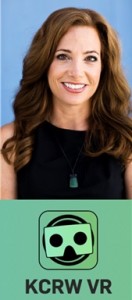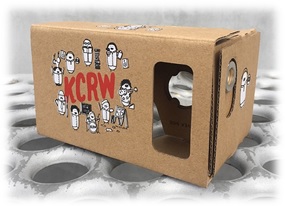KCRW in Los Angeles is one those legendary public media stations, including being one of the charter members of NPR way back in 1970. The call letters stand for College Radio Workshop, and the station is owned by the Santa Monica Community College. But unlike many heritage public radio stations, KCRW has a well-deserved rep for innovation, whether it comes to music, live performance, or technical achievements. This is a brand that doesn’t flinch when it comes to taking a leap.
 In addition to airing network programs from NPR, PRI, and others, KCRW is famous for its eclectic music and cultural programming, including classic shows like Morning Becomes Eclectic as well as an emphasis on live performance. KCRW’s President, Jennifer Ferro, has been with the station nearly two decades, and is charged with providing leadership to an iconic station as it moves into a new three-story state of the art building, while navigating the media disruption and change that is all around us.
In addition to airing network programs from NPR, PRI, and others, KCRW is famous for its eclectic music and cultural programming, including classic shows like Morning Becomes Eclectic as well as an emphasis on live performance. KCRW’s President, Jennifer Ferro, has been with the station nearly two decades, and is charged with providing leadership to an iconic station as it moves into a new three-story state of the art building, while navigating the media disruption and change that is all around us.
KCRW has always been about innovation and risk-taking. Last month, they proved it again with the development of a virtual reality initiative that made waves throughout the media industry. There’s a lot to be said for doing it first and doing it right. KCRW has accomplished both with VR, providing a template or jumping off point for other radio groups and brands to consider.
We talked about the notion of taking the audience “backstage” in a blog post here last week. We believe radio has an opportunity to provide unique experiences to audiences using new technology like virtual reality, helping to keep the medium relevant and important. VR is one those tools that enables the audience to go behind the velvet ropes, experiencing sights and sounds that simply haven’t been practical or possible to present.
Whether VR becomes a mainstream hit or a tech attempt like QR Codes that had promise but never was embraced by consumers remains to be seen. Facebook’s $2 billion acquisition of VR gear maker Oculus suggests this is more than a fad. Paul McCartney has embraced VR, and the video game Rock Band has a virtual reality version coming out later this year. Investments have continued to flood into virtual reality initiatives, and based on the buzz at CES this year, VR is on its way.
This post contains two videos. The first takes you behind the scenes so you can what went into pulling off this virtual reality first. The second is the VR video KCRW produced with the band Death Cab For Cutie. Of course, it is best viewed by downloading KCRW’s VR app (iOS or Android), and experiencing it through a viewer like the Google Cardboard pictured here.
Jennifer let us have a look under KCRW’s VR hood, as we celebrate their efforts in VR as “Radio’s Most Innovative” this week.
JM: Where did the idea to integrate virtual reality into KCRW programming originate?
JF: Several of our digital and video team members had been aware of VR for some time and lobbied for us to invest a small amount in it. As the market got more familiar with VR, we decided the time was right to launch it. Our goal with VR is to use it as a means to virtually invite our audience into our basement studios for some of our live performances. Something we could never do in the “real world” due to the small size of our space. We’re always interested in exploring how technology can enhance what we do.
JM: Why did you think you could pull this off technically? What was most challenging?
JF: Being a community driven organization we were fortunate enough to be able to reach out to some pioneers in the field that were also friends of the station. They provided us with some initial guidance and helped get our efforts off the ground – including the most challenging aspect of the effort – building our custom laser cut rig to hold eight GoPro cameras and modify the cameras to get a wider angle.
Email recipients can watch the video here
JM: How long did it take from the project’s conception to its completion?
JF: We’d been toying with the idea for a while. But then an opportunity presented itself to film Death Cab for Cutie in VR and we decided to jump on it. This didn’t give us much time – we had two weeks to get everything ready for production. Since then we have spent months filming more artists and finalizing our app.
JM: In the question about whether to follow the audience or lead them, what role does KCRW play?
JF: We like to do both. Our first interest is to be where our audience is, so I guess that’s the following part. We also like to jump in and experiment. I think it starts with us not thinking of ourselves as just a radio station. We’re a community and we know our community is ready to experiment along with us.
 JM: Are you concerned about being ahead of the audience?
JM: Are you concerned about being ahead of the audience?
JF: We’ll never be completely ahead of our audience. We tend to do so many things that you can consume KCRW in whatever speed you like – traditional radio, a music stream, on demand programs, on your iPhone, at an event, connect through Spotify or YouTube or watch us with the new VR app.
JM: Tell us about the various teams at the station and how they worked together as well as individually to make this happen?
JF: The effort was led by our digital and video teams that work hand-in-hand on a daily basis. The tricky part was being able to stick to our regular schedule of on-air live performances. We ask the artist to do an extra song with the VR rig then re-set for the regular multi-camera video performance which often is live on the air at the same time. All our bands and artists have very limited time and are coming to us largely to do an on-air radio performance. Convincing them to take the extra time to record VR has been a challenge, mainly because we have to explain what it is. Each week more and more people know about VR though.
JM: What was the process like with Death Cab, and do you feel this opens the door to other artists?
JF: We reached out to Death Cab first because they had just made a VR video for one of their songs. They were already scheduled to come to KCRW and we knew they would understand what we were talking about. They said, “Let’s do it!” and so we were on our way.
Email recipients can watch the KCRW VR/Death Cab For Cutie video here
JM: Have other artists been contacting you?
JF: Since launching our VR effort, we have heard from several bands that want to do a VR shoot with us.
JM: What other types of experiences do you plan on creating with your VR initiative?
JF: VR opens the door for new ways of storytelling. A live music performance is a slam dunk because it really does enhance your experience. We’re interested in working with visual storytellers next to see how they could use this technology to tell a story in a new way.
JM: What kind of feedback have you gotten from listeners?
JF: It’s been overwhelmingly positive so far. KCRW has a reputation for staying ahead of the curve and this is just one more example.
We’ve had to remind ourselves that not everyone knows what “VR” means so we’ve done a lot of education to explain the 360 nature of the experience.
JM: What was your favorite part of this experiment?
JF: The best part is the communal nature of these things. My staff gets to learn new technology, and we have an opportunity to reach out to people who are experts in their field and want to help us. Working together with partners who are invested in your success is exciting.

JM: Why are these types of initiatives important to KCRW and the radio industry in general?
JF: I can’t speak for the commercial radio industry because I don’t know it well. For public radio, the one thing that we have that travels through changing behaviors and technology is our relationship with our audience. Just like any good relationship you have to keep it fresh and always be a little surprising. We believe VR adds value to the experience of discovering music, and we’re constantly looking for those elements that make us a good partner to commit to.
JM: Where does VR for radio stations go from here? What other applications for VR and radio do you envision?
JF: I don’t know that any other radio stations are using VR right now. But I think we can visualize our content in a way that we hadn’t thought of before. VR can turn everyone into a director. It’s is a great opportunity to connect with people who want to see what they are hearing. (That should mean so much more than putting 360 degree cameras in your studio!)
JM: Many say that broadcast music stations are being usurped by pure-plays? What’s your response to that and how does KCRW’s VR initiative fit into that?
JF: Again, we’re not exactly a broadcast music station. We’re a multi-format public radio station that also has a pure-play 24 hour music station, Eclectic24. We dabble in all of it if we can. Again, all of our initiatives go towards satisfying our community and using tools to build and enhance that community. VR is a way to make a deeper connection to music fans who are looking for that.
JM: What is your advice for other stations or radio people with an innovative idea they’d like to get off the ground?
JF: You’re asking advice from a public radio person? Start small, experiment and see what happens. What’s the worst that can happen? I think the worst that can happen is finding yourself irrelevant to your audience.
INNOVATION QUOTE OF THE WEEK
“Being good in business is the most fascinating kind of art. Making money is art and working is art and good business is the best art.”
Andy Warhol
Check out some of our “Past Innovators” here:
- December 18 Liquidus
- January 8 KISW’s Live Day
- January 15 WNYC Studios, Part 1
- January 22 WNYC Studios, Part 2
- What To Do If Your Radio Station Goes Through A Midlife Crisis - April 25, 2025
- A 2020 Lesson?It Could All Be Gone In A Flash - April 24, 2025
- How AI Can Give Radio Personalities More…PERSONALITY - April 23, 2025





Leave a Reply